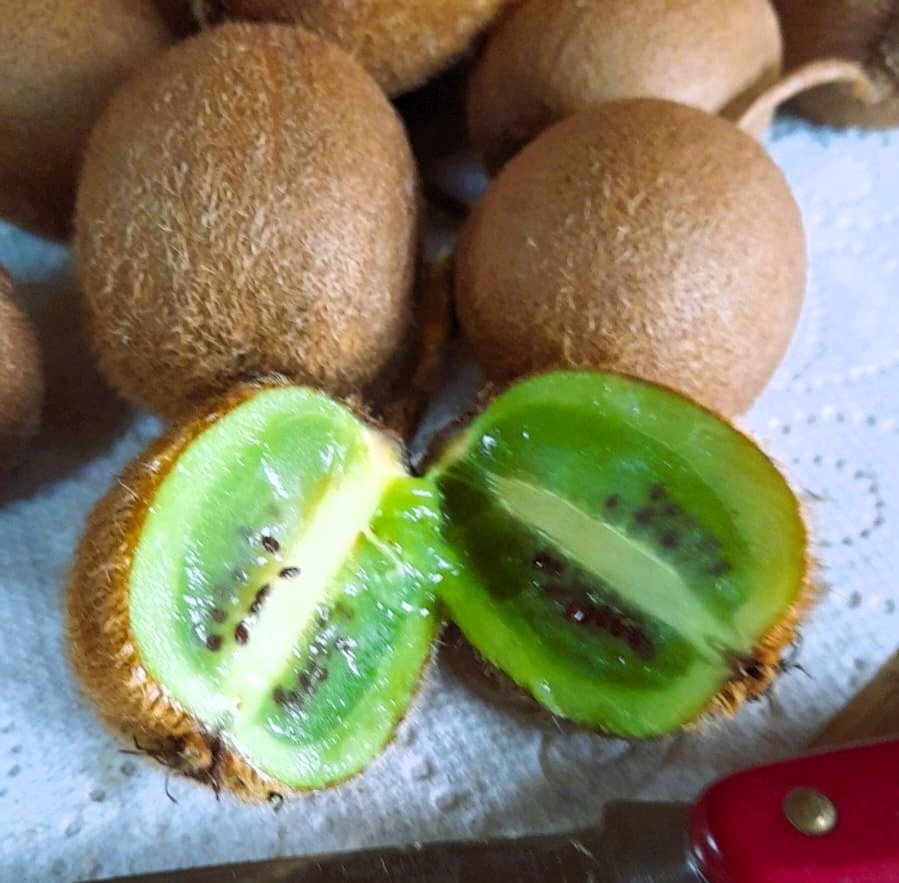Simon’s TOP TIPS on growing Kiwi Fruit
The picture below shows some Kiwi fruits from the self-fertile Kiwi vine, Actinidia deliciosa, variety Jenny from the Forest Garden Falmouth.
Kiwi fruits are often mistaken for a tropical species. In fact, they originate from China thriving in a similar temperate climate to that of the southern counties and west coast of the UK.Known as Chinese gooseberries they were traded with New Zealand who have grown them commercially for many years. These plants are climbing vines and although they are trained commercially on frames (that enable you to harvest them more easily) in nature they are an aggressive climber, capable of growing 5m plus a year.
At the Forest Garden, the vine bearing these fruits, was planted at the base of a six year-old Italian Alder tree, eight years ago. Producing its first six fruits last year there were thirty three fruits this year, with expectations of over a hundred next year.
Being nitrogen fixing trees, Italian Alders, suit the hosting task very well and are accommodating to vine activity.
The harvest period is November to February. The egg sized fruits need to go slightly soft prior to eating the most delicious flesh, which just melts in the mouth and tingles the palette.
These are not as large as the imported varieties. However, here at the Forest Garden Falmouth ‘It’s all about the taste’ and Kiwi vines are usually included with other species within our plant availability list.
There are plenty of fields in Cornwall that are too small, and or steep, to accommodate modern farm machinery, that would lend themselves to being planted with Kiwi vines. It would provide a useful return during in the winter months to landowners. UK grown Kiwis would help reduce the carbon footprint, too.
In East Cornwall one established forest garden picks hundreds of boxes of kiwi’s a year.
Other useful varieties like Heyward a female form, to be pollenated by a male like Atlas, or Tomuri produce slightly larger fruits than the form Jenny. However, two vines will take up more space. Often self-fertile forms of any plant will perform better with a male form nearby.
If these vines are not allowed to climb, they often become a sprawling nightmare scrambling everywhere, with no shape of form. The plants tendrils wrapping around each other in a desperate attempt to attach to something and get airborne.
One of my clients shared with me that he juices the furry kiwi with the skins on and waits till the hairs settle to the bottom of the storage container prior to decanting off. He said the flavour was amazing.
If you are in a colder part of the UK, there’s a hardy form of Kiwi, called Actinidia arguta. This is a smoothed skinned form, about the size of a grape, and packed with flavour, some say up to 4 times more than its fury cousin. These too, will climb well. I have found a good framework for these plants to climb is the nitrogen fixing Elaeagnus umbelata as it leaves the fruit in reach for easy picking, plus there’s an edible berry on the Elaeagnus, as too.
These are smaller growing vines some male, some female, and some self-fertile, with an October harvest, with flavour to die for. Just check on purchasing your vines that the male and female have compatible flowering times, sometimes this is reflected in the vines name, such as Actinidia arguta Weiki (male) and Weiki (female)
With either type, once the vine starts to produce, the fruit keeps increasing annually with little to no human input.
Enjoy your forest gardening!
Simon H Miles
13/03/2025
• Copyright© Simon H Miles, The Forest Garden Falmouth, 2025

